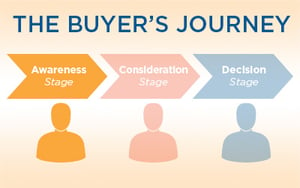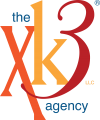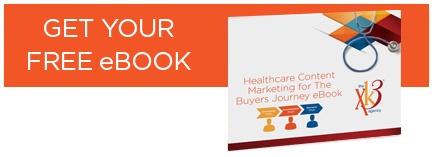Content Marketing for The Buyer's Journey Part 1: The Awareness Stage

Content Marketing might mean a lot of things to a lot of people, but most people agree on one thing. A good content marketing plan should include content for each of the three stages of the buyer's journey.
- Awareness stage identifies the problem or opportunity
- Consideration stage investigates solutions
- Decision stage highlights what makes you the best solution
You Need Content for Each Stage of the Buyer's Journey
Why is it essential to create content for each stage? It comes down to context. The information people need at each stage is different.
People in the awareness stage are still grappling to define the problem or opportunity ahead of them. They need foundational information that helps them understand the lay of the land and put a name to the challenge or opportunity they face.
Consideration stage content moves a step further. Once the problem or opportunity is better understood, there may be many types of solutions. Which strategy is best? Consideration stage content explores the various solutions strategies.
The decision stage focuses on a specific solution strategy. Ideally, this approach is one you offer, and this becomes your opportunity to highlight why you are a better choice than the competition.
Download Your FREE eBook "Content Marketing for The Buyer's Journey"
Define the Problem or Opportunity in the Awareness Stage
It's helpful to remember that the content you create isn't about you. It's about solving problems for others. Awareness stage content goes right to the heart of the matter. It should define the problem or opportunity into words and concepts the customer can understand.
When customers don't even know where to start, give them the foundation needed to understand where to go next. Even if it isn't you that they buy from, they'll remember where they took that first step.
What types of content work well in the awareness stage?
- Analyst reports
- Research reports
- eBooks
- Editorial content
- Expert content
- Whitepapers
What do all these formats have in common? They educate without being pushy towards a sale. People can learn on their own from these resources. You are helping them learn, but they won't forget who helped them understand the next step to take.
How does Awareness Content work in the wild?
Take for example a business looking to grow. What is the problem or opportunity? A company may have a number of them, but a primary one might be the need for a lot more leads. Content that defines how more leads can grow a business puts a name to the problem. If your company is one that helps them generate leads, then your content needs to talk about lead generation can generate growth.
It's important to note that when people were searching for ways to grow a business, they may not have thought of lead generation at all. The idea of lead generation emerged from the search for business growth. In fact, your content introduced the concept of lead generation as a possible solution to growth challenges. Once lead generation was identified, it put a name to the most significant problem ahead.
Keep Awareness Content Educational
The most important element of content created for the awareness stage is the content should educate. Buyer's in this part of the journey are still learning. They don't have answers to their problems because in many cases they haven't defined the problem or opportunity ahead. They aren't ready to buy. They need more information before making a purchase.
Creating awareness stage content also requires an understanding behind the logical leap between broader topics and the more specific problems or opportunities related to those topics. In the case of business growth, lack of leads identifies the more specific challenge. If your business helps generate leads, then your content should help people make the connection between growth and lead generation.
Once someone searching for ways to grow a business makes the connection to lead generation, that person can then move deeper into the journey by evaluating different ways to generate leads. It's at this point the consideration stage begins.
In our next article, we'll dig deeper into consideration stage, and what types of content work well during this part of the buyer's journey.
Don't miss the next two parts of the series: Part 2 and Part 3.
--
Download this series of articles in a detailed eBook format!
Subscribe to email updates
Popular Posts
- Alternative Methods of Marketing Your Healthcare Business When You Can't Get Out to Network
- Content Marketing for The Buyer's Journey Part 1: The Awareness Stage
- How Inbound Marketing Can Help Grow Your Healthcare Business - Part 1
- Content Marketing for The Buyer's Journey Part 2: The Consideration Stage
- Content Marketing for the Buyer's Journey Part 3: The Decision Stage
- Wait, Are Keywords Dead? Not Necessarily, but Topic Clusters Are the SEO For Today
- Your Complete Guide to Conducting Connect Calls the Inbound Way
- A Culture that Elevates People is the Crucible Where Good Brands Are Created
- 6 Essential Steps to a Successful Rebrand
- Responsive Design Isn't Enough. You Need to Create a Remarkable Mobile Experience.


